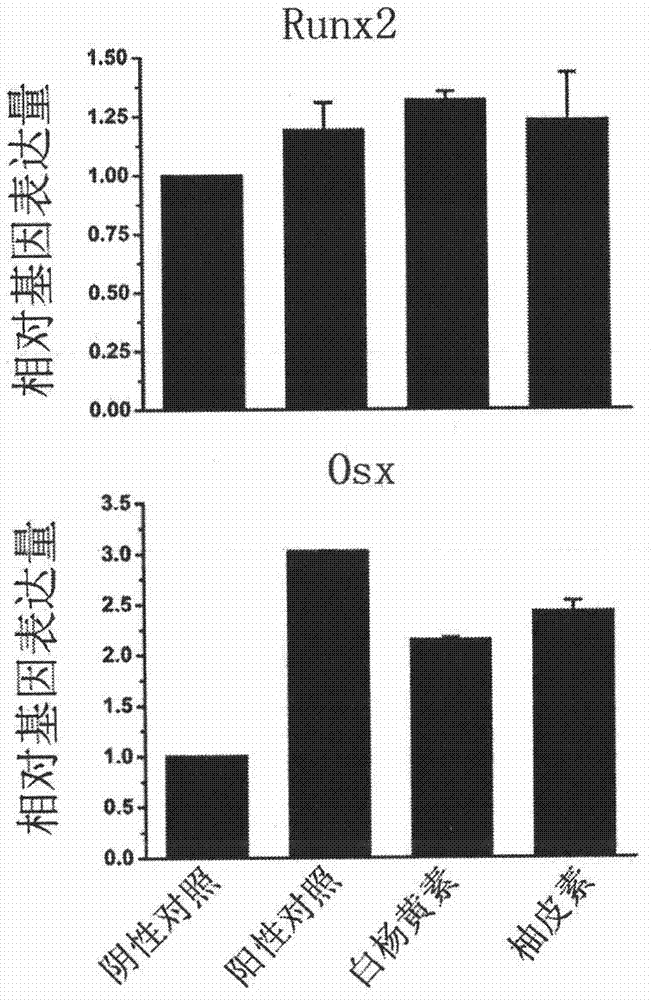Application of flavonoid micromolecule in prevention and treatment of diseases related to bone resorption
A technology of flavonoids and small molecular compounds, which is used in bone diseases, medical preparations containing active ingredients, organic active ingredients, etc.
- Summary
- Abstract
- Description
- Claims
- Application Information
AI Technical Summary
Problems solved by technology
Method used
Image
Examples
Embodiment 1
[0024] Example 1. Chrysin and naringenin on the osteogenic differentiation of mouse osteoblast cell line MC3T3-E1
[0025] (1), maintenance culture of MC3T3-E1 cell line:
[0026] MC3T3-E1 cell line was purchased from ATCC, number CRL-2593 TM . The initial inoculation density was 3×10 4 / cm 2, inoculated into Corning T25 cell culture flask (bottom area is 25cm 2 ), the culture medium is high-glucose DMEM medium (containing 10% fetal bovine serum); the culture environment is 37°C, 5% CO 2 . When the cells adhered to the wall and grew to 90% bridging degree, they were digested with 0.25% trypsin at 37°C for 5 minutes to neutralize the activity of trypsin, and the cells were collected by centrifugation for later use.
[0027] (2), osteoblast differentiation induction culture:
[0028] Set the density to 8×10 3 The MC3T3-E1 cells in the cell / dish were planted in a cell culture dish with a diameter of 6 cm, and the cells were divided into the following groups according to d...
Embodiment 2
[0052] Example 2. The osteogenic differentiation of chrysin and naringenin on human primary periodontal ligament cells
[0053] The alveolar bone is the supporting tissue for the teeth. The part of the tooth embedded in the alveolar bone is covered with a layer of periodontal ligament fibrous cells (referred to as periodontal ligament cells). When the alveolar bone is damaged (mechanical injury or inflammatory injury), the periodontal ligament cells will differentiate Osteoblasts repair damaged parts. The source of this group of cells is mesenchymal stem cells, which have the ability to differentiate into bone cells, chondrocytes and fat cells. In periodontal diseases, such as periodontitis or apical periodontitis, the osteogenic differentiation ability of periodontal ligament cells is weakened and inflammatory bone resorption is enhanced in the inflammatory environment of alveolar osteoarthritis.
[0054] (1) Acquisition of primary human periodontal ligament cells:
[0055...
Embodiment 3
[0064] Example 3. Naringenin and chrysinin alleviate the inhibitory effect of the inflammatory environment on the osteogenic differentiation of the mouse osteoblast cell line MC3T3-E1.
[0065] Many chronic inflammatory environments associated with bone resorption are inflammatory responses mediated by Toll-like receptor family proteins on the cell surface, free fatty acids in obese patients, endotoxin lipopolysaccharide (LPS) in infected patients, and massive apoptosis in tumor patients Nucleic acid fragments released by cells can activate the inflammatory response mediated by Toll-like receptor family proteins and release the inflammatory factor TNF-α.
[0066] After being stimulated by LPS, MC3T3-E1 cells, like macrophages, can also produce inflammatory factors, such as TNF-α. Afterwards, the osteogenic differentiation of MC3T3-E1 cells was inhibited to a certain extent, and the treatment with naringenin or chrysin could significantly improve the inhibitory effect of LPS on M...
PUM
 Login to View More
Login to View More Abstract
Description
Claims
Application Information
 Login to View More
Login to View More - Generate Ideas
- Intellectual Property
- Life Sciences
- Materials
- Tech Scout
- Unparalleled Data Quality
- Higher Quality Content
- 60% Fewer Hallucinations
Browse by: Latest US Patents, China's latest patents, Technical Efficacy Thesaurus, Application Domain, Technology Topic, Popular Technical Reports.
© 2025 PatSnap. All rights reserved.Legal|Privacy policy|Modern Slavery Act Transparency Statement|Sitemap|About US| Contact US: help@patsnap.com



